Reptiles and Amphibians

Photo: Malayan Water Monitor (Varanus salvator) (Credit: Ruth Tan)
Jurong Lake Gardens is home to a number of reptile and amphibian species. Both reptiles and amphibians are ectotherms, or cold-blooded, and rely on external sources to maintain their body temperature. You’ll often see reptiles such as water monitor lizards and terrapins basking in the sun to warm up.
Reptiles lay eggs with shells on land. Most amphibians, on the other hand, begin their life as eggs in water that hatch into aquatic larvae (e.g. tadpoles), which later develop into adults that can survive on land. These eggs are covered by a transparent jelly-like substance.
Click to find out more about some of the commonly seen reptiles and amphibians in Jurong Lake Gardens!
Reptiles
Malayan Water Monitor

Photo: Loke Peng Fai
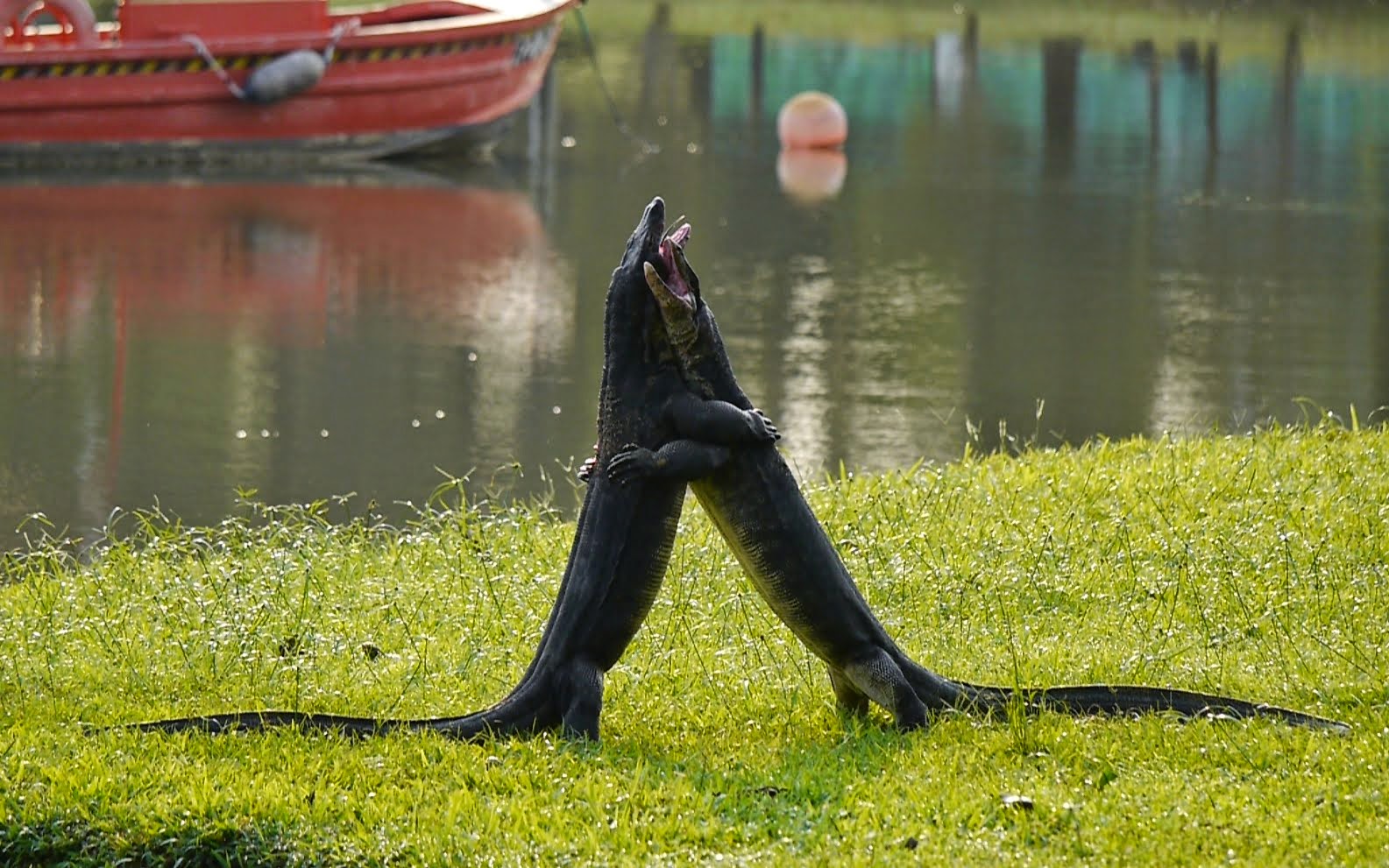
Two males wrestling. Photo: Perlyn Chng
|
Scientific name: |
Varanus salvator |
|
Common name: |
Malayan Water Monitor |
|
Family: |
Varanidae |
What does it look like?
It is a large greyish brown lizard with leathery skin and non-overlapping scales. Its tongue is slender and forked. In Singapore, it is often mistaken for the Estuarine Crocodile (Crocodylus porosus) and is also a smaller relative of the Komodo Dragon (Varanus komodoensis). You can usually spot a few of them roaming around Jurong Lake Gardens.
Behaviour and Ecology
Diet and Behaviour
The Malayan Water Monitor eats fishes, frogs, crabs, birds and other small animals, and has been known to scavenge on dead animals. It hunts during the day. This generalist diet allows it to be very adaptable to even highly disturbed environments.
These reptiles are usually shy, preferring to run from disturbance. It is advisable to leave them alone as they may become aggressive when cornered.
Where is it found?
It can be found in our forests, mangroves, parks and gardens, and tends to stay close to water bodies. It is mainly terrestrial but can also climb trees. It can sometimes be seen diving into the water from treetops at mangroves at Pasir Ris Park and Sungei Buloh Wetland Reserve.
It can also be found in urban areas, usually near canals. It is distributed from Sri Lanka and southern China to Southeast Asia.
Did you know?
When you see two monitors “hugging” each other, they are actually two males engaged in a wrestling match. The one that pushes the other onto the ground wins the favour of the female monitor they are trying to impress!
Changeable Lizard
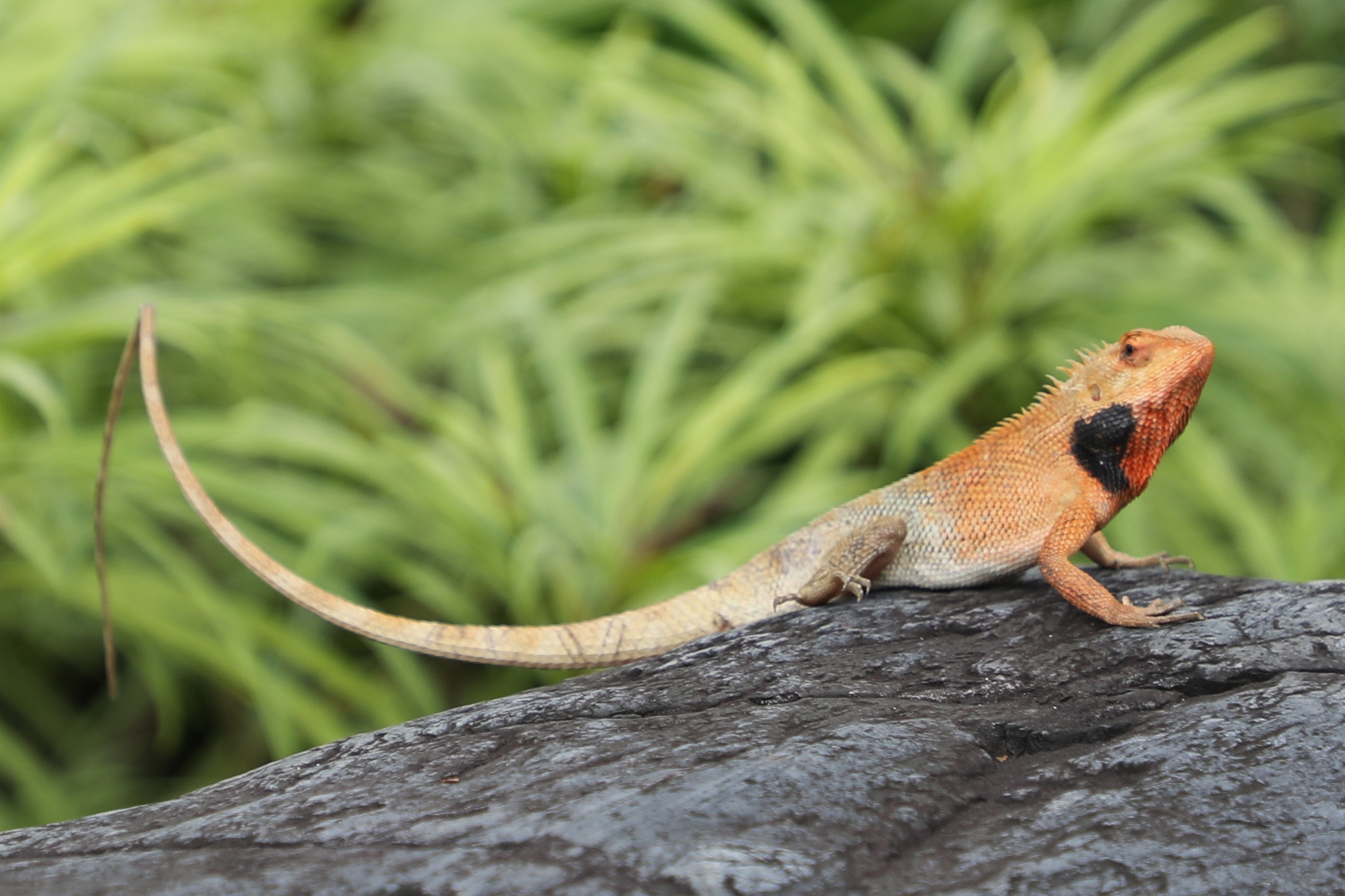
Male in breeding colours. Photo: Ruth Tan (NParks)
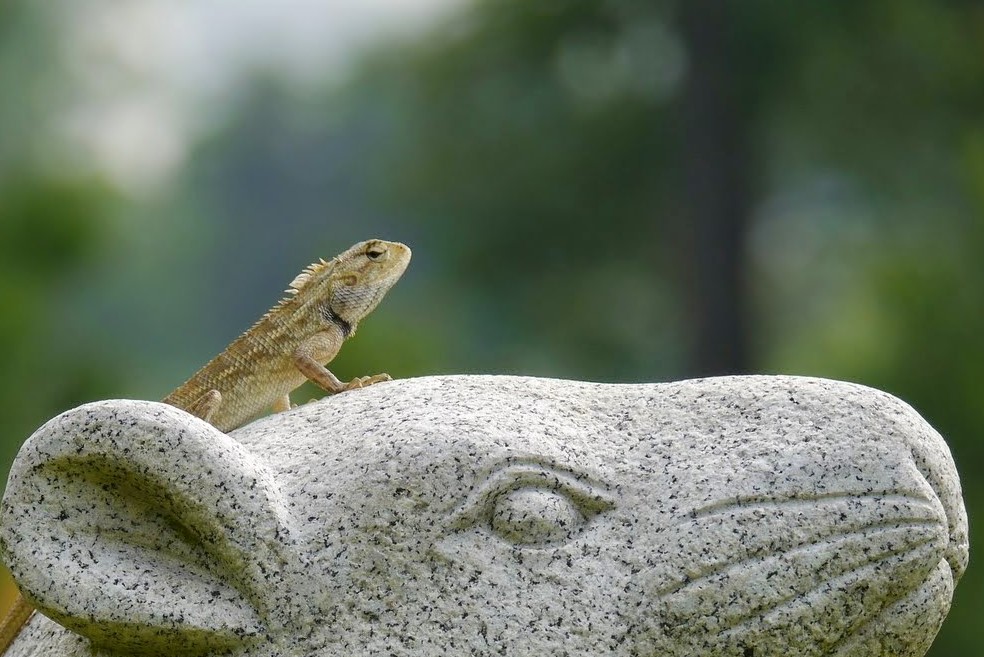
Male in non-breeding colours. Photo: Perlyn Chng
|
Scientific name: |
Calotes versicolor |
|
Common name: |
Changeable Lizard |
|
Family: |
Agamidae |
What does it look like?
This introduced lizard is commonly spotted on tree trunks in our parks and urban areas. It is often mistaken for a chameleon, which is not found in this region. It has a stout body with ridged scales and a spiny crest along the middle of its nape and back. Its long tail can grow up to twice its body length!
They are sexually dimorphic. Males are larger with swollen cheeks and develop bright orange heads with a black blotch on their cheeks and throat during breeding season.
Behaviour and Ecology
Diet and Behaviour
It eats insects and other smaller lizards. It is active during the day and is often found basking on bushes and trees. During breeding season, males become more territorial and can be seen displaying head bobs and “push-ups” to attract females.
Where is it found?
The Changeable Lizard was believed to have been introduced into Singapore in the 1980s and has rapidly spread across the island, including urban areas. Our native lizard, the Green Crested Lizard (Bronchocela cristatella), has been largely displaced by the Changeable Lizard and is now not commonly seen.
Its native range encompasses the Middle East, the Indian Subcontinent, China and Southeast Asia. It has been introduced to Singapore, the United States and Brunei, among other places.
Did you know?
Unlike many lizards, it does not drop its tail when in danger. This phenomenon, called autotomy, acts as a distraction to predators to help the lizard escape.
Common House Gecko
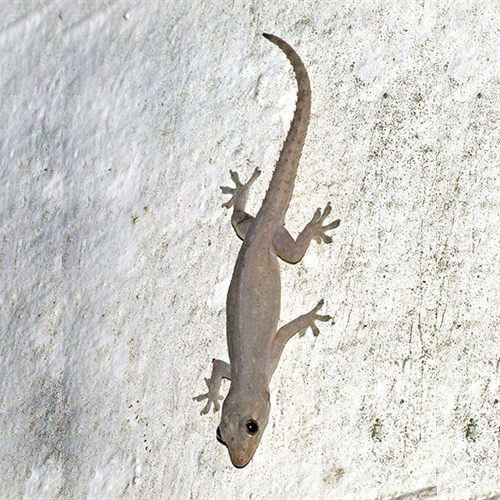
Photo: NParks Flora & Fauna Web
|
Scientific name: |
Hemidactylus frenatus |
|
Common name: |
Common House Gecko or Spiny-tailed Gecko |
|
Family: |
Gekkonidae |
What does it look like?
This common gecko has thin skin and non-overlapping scales. Its toes are expanded into pads that allow it to stick to vertical surfaces such as trees and walls. It has whorls of small spines on its tail unless the tail had been autotomised (dropped) and regrown.
Behaviour and Ecology
Diet and Behaviour
Geckos are nocturnal lizards that hide during the day and are often seen climbing walls of buildings in search of insects at night. True to their name, they have a preference for urban environments. They can carry out autotomy, where they shed their tail as a self-defence mechanism.
Where are they found?
It is very adaptable and is often seen in urban areas and nearby forests. While it is a tropical lizard that is native to Southeast Asia, it has also been introduced to many countries in the Americas, Pacific and other parts of Asia where it has negatively impacted native gecko species.
Red-eared Slider

Photo: Cai Yixiong, NParks Flora & Fauna Web
|
Scientific name: |
Trachemys scripta elegans |
|
Common name: |
Red-eared Slider |
|
Family: |
Emydidae |
What does it look like?
These terrapins are a common sight in Singapore as they are popular pets. However, they are an exotic species. They have a dome-shaped shell that is olive brown with yellowish streaks. They are easily identified by the broad red stripe behind their eye. Some individuals can be found in the Eco Pond at Lakeside Garden. The shell of a typical Red-eared Slider grows to about 15-20 cm long.
Behaviour and Ecology
Diet and Behaviour
While they will eat whatever they can find, they are mostly herbivorous. As they are cold-blooded, like other reptiles, they often need to sunbathe to maintain their body temperature. You can often spot them lying on rocks motionlessly, basking in the sun.
Where is it found?
Due to the release of unwanted pets, the Red-eared Slider is found in almost every freshwater pond and reservoir in Singapore. It is native to North America and is the most widely traded pet reptile in the world. It is mostly bought as an attractive juvenile but is often released into the wild when it reaches adulthood by irresponsible pet owners.
Did you know?
It is illegal to release or abandon any animal in our parks and nature reserves. The Red-Eared Slider’s ability to survive in a wide range of freshwater habitats makes it a potential threat to our native aquatic biodiversity!
Oriental Whip Snake
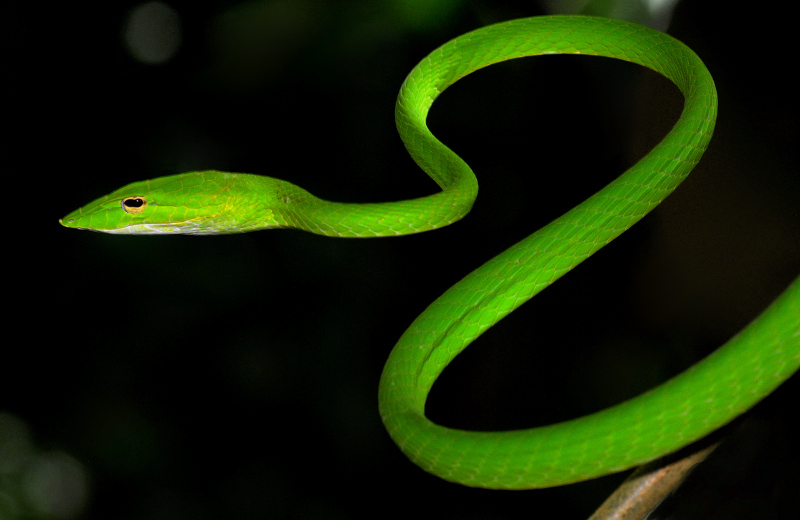
Photo: Daniel Ng (NParks)
|
Scientific name: |
Ahaetulla prasina |
|
Common name: |
Oriental Whip Snake |
|
Family: |
Colubridae |
What does it look like?
Adults of this beautiful snake are a striking bright green, while juveniles are brownish. It has yellow eyes, with horizontally elongated pupils.
Behaviour and Ecology
Diet and Behaviour
It eats mainly small lizards as well as frogs and small birds. Its body colour camouflages it well among the foliage during the daytime when it is most active.
When threatened, it will extend its tongue and leave it out as a warning. It is usually docile but is mildly venomous.
Where is it found?
The Oriental Whip Snake is arboreal, meaning it lives in trees and bushes. It is common in our forests, urban gardens and coastal areas like mangrove forests. It is found throughout Southeast Asia, China, Indochina and the Indian subcontinent.
Did you know?
While it may seem like the female Oriental Whip Snake gives birth to live young, this is actually a case of ovovivipary, where the eggs produced by the female hatch within its body!
Amphibians
Green Paddy Frog
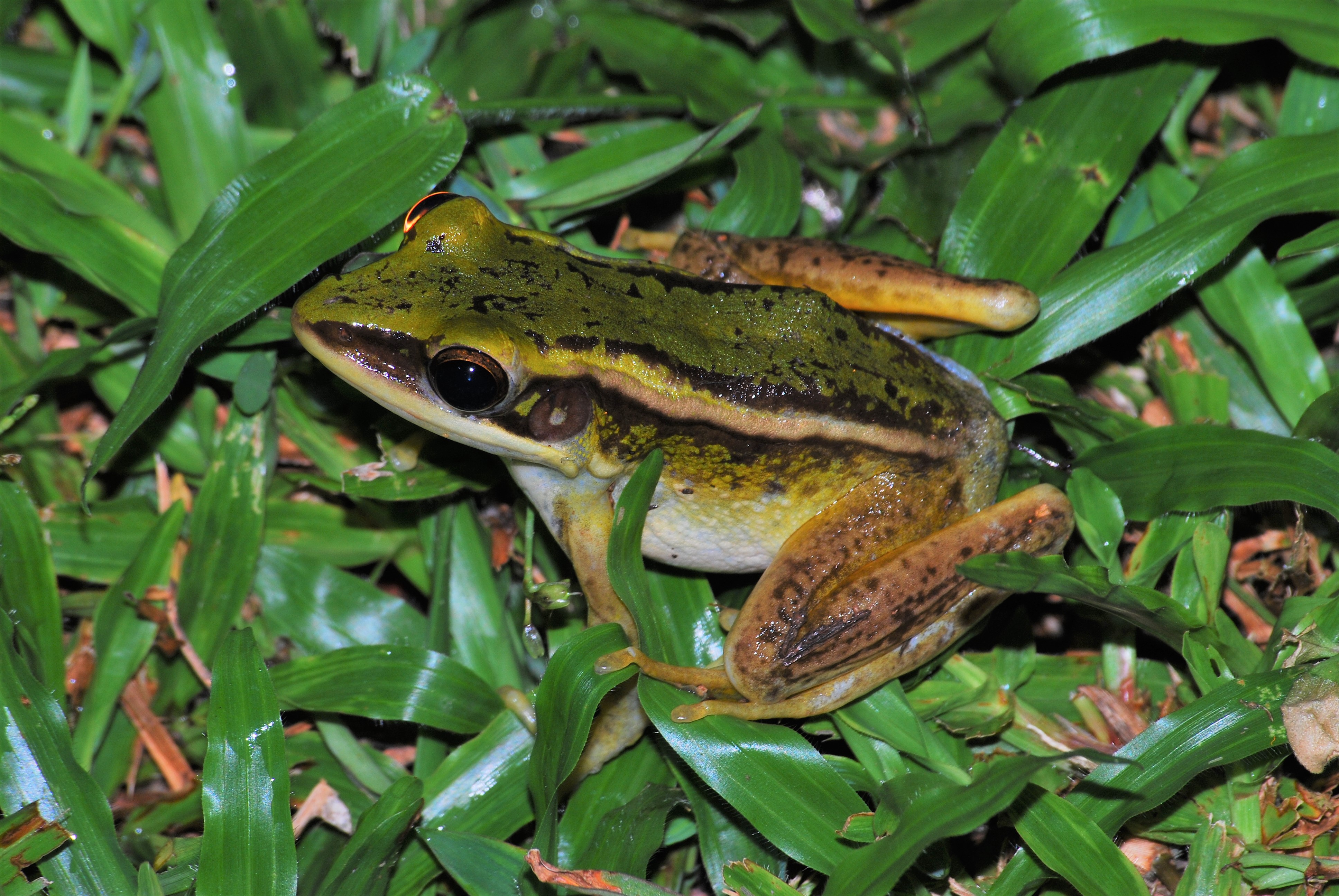
Photo: Daniel Ng (NParks)
|
Scientific name: |
Hylarana erythraea |
|
Common name: |
Green Paddy Frog |
|
Family: |
Ranidae |
What does it look like?
This is a common frog found in Singapore. It has a distinctive white band running along the side of its body and a white upper lip. Its top side is usually bright green, and sometimes brown.
Behaviour and Ecology
Diet and Behaviour
The Green Paddy Frog feeds mainly on insects and is generally nocturnal.
Where are they found?
You can spot them along the banks of freshwater bodies such as Jurong Lake, as well as at other ponds and reservoirs. Their large tadpoles can be found in still waters, such as in ponds and ditches.
They can be found in many countries across Southeast Asia.
Did you know?
As amphibians such as the Green Paddy Frog require clean aquatic habitats to thrive, they often act as biological indicators of the health of the ecosystem.
Günther's Frog
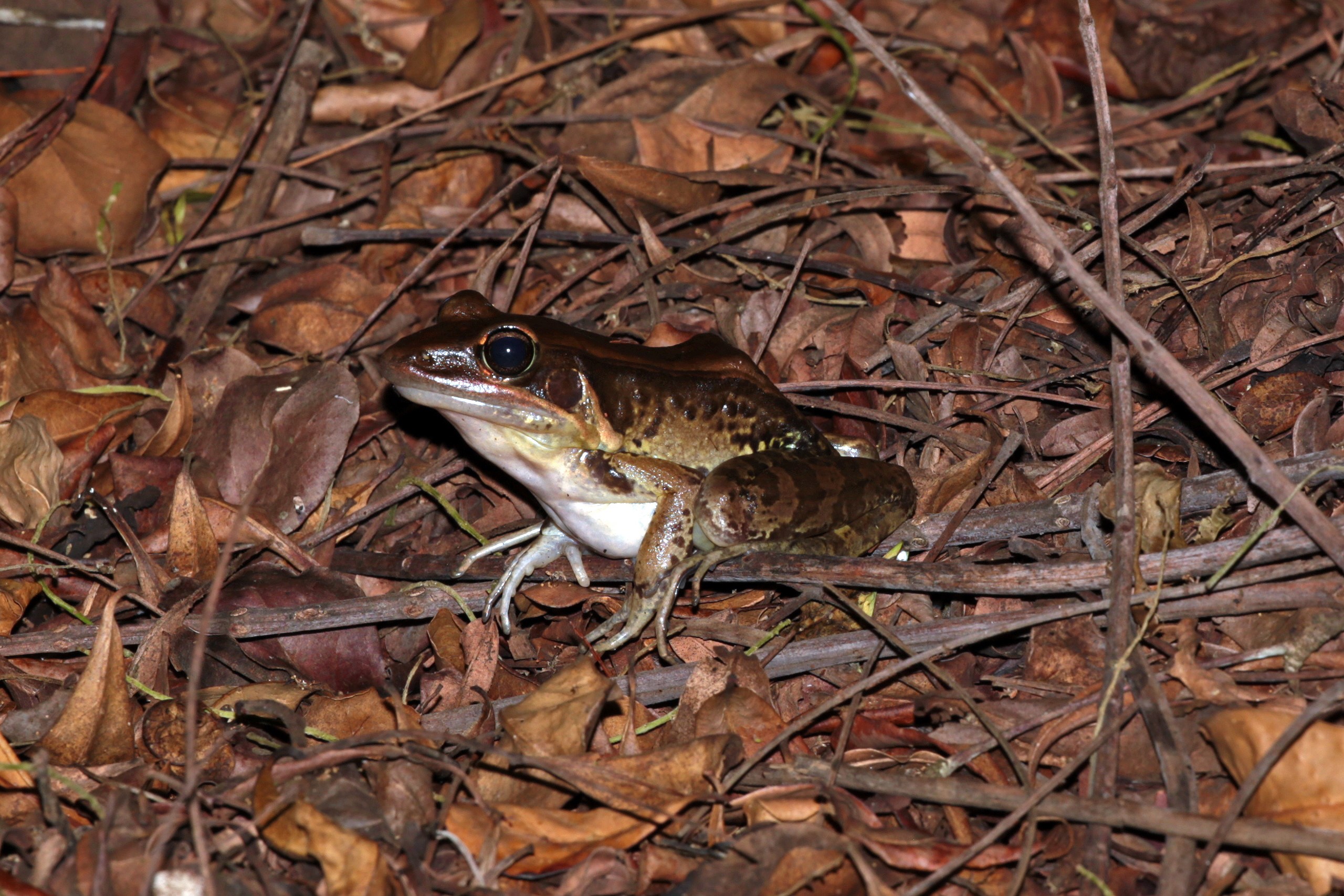
Photo: Noel Thomas
|
Scientific name: |
Sylvirana guentheri |
|
Common name: |
Günther's Frog |
|
Family: |
Ranidae |
What does it look like?
This introduced frog has a pale brown back, dark brown sides and a distinctive large eardrum surrounded by a light yellow ring. This species can be spotted in the freshwater swamp at Jurong Lake Gardens.
Behaviour and Ecology
Diet and Behaviour
They feed mainly on invertebrates and are often found in disturbed habitats.
Where are they found?
Its native range includes southern China and Vietnam, but it has been introduced to the islands of Guam and Singapore. Usually found in open swampy habitats, it thrives in human-disturbed habitats as well.
It is thought to have been introduced to Singapore via ornamental plants. Its calls were first heard in Singapore in 1997.
Did you know?
Günther's Frog has toxic skin secretions that are known to be lethal to other frogs in enclosed environments
Four-lined Tree Frog
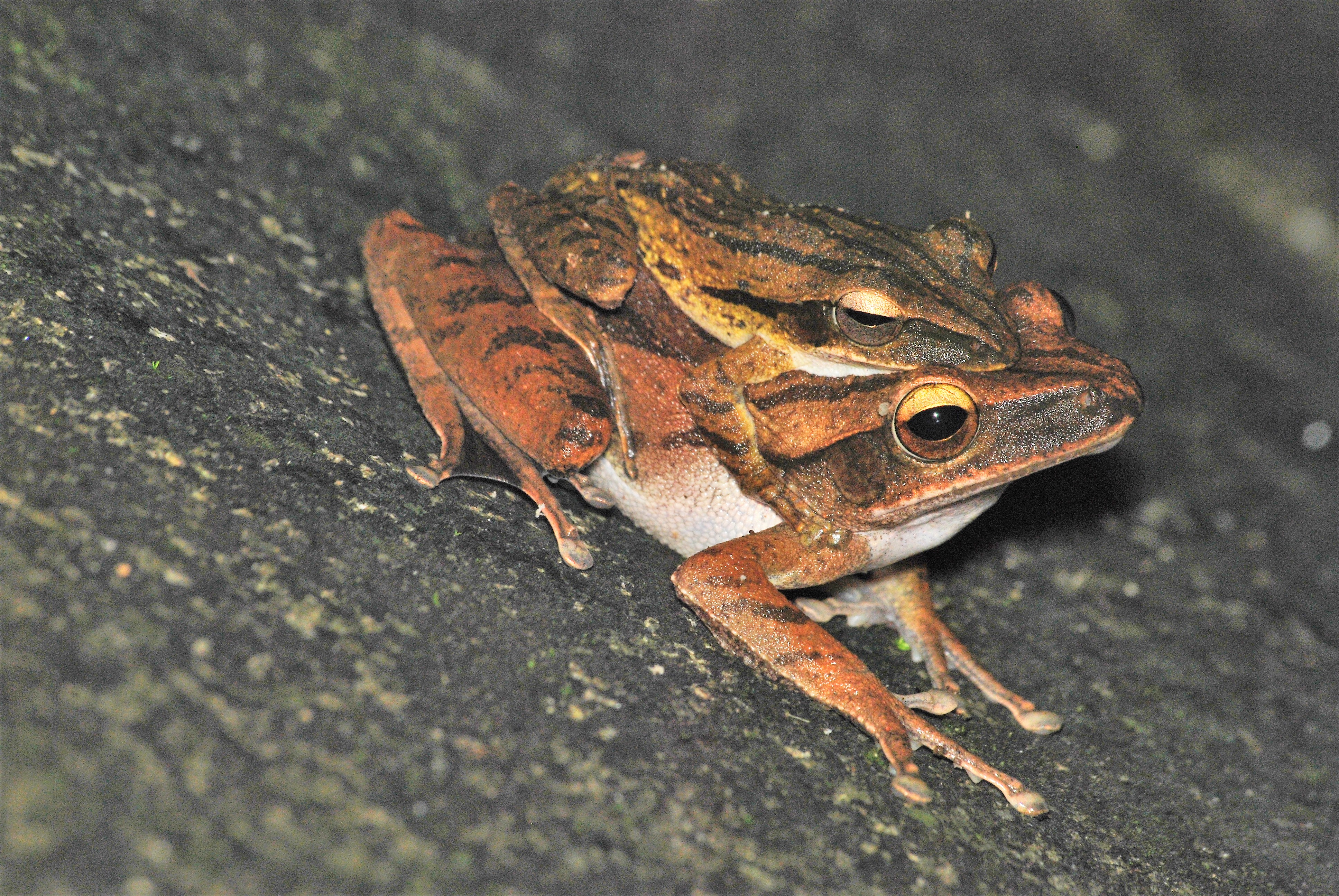
Photo: Daniel Ng (NParks)
|
Scientific name: |
Polypedates leucomystax |
|
Common name: |
Four-lined Tree Frog |
|
Family: |
Rhacophoridae |
What does it look like?
Individuals in Malaysia and Singapore tend to have a series of dark stripes on their upper bodies, while those in Java and other territories may have spotted or speckled forms. Their snouts are pointed and only their hind feet are webbed.
While they are a relatively small species, females are generally stouter than their male counterparts. Their large tadpoles have a pale spot on the tip of their snout.
Behaviour and Ecology
Diet and Behaviour
They feed on insects at night. They live on plants and breed at the edge of shallow pools, where they build nests made of foam on plants or rocks. This foam protects its fertilised eggs.
They have a loud, distinctive call which is a loud, nasal duck-like quack often heard during rainstorms, making them easily recognisable in our parks and gardens.
Where are they found?
The Four-lined Tree Frog has adapted to many environments and can live in forest edges, wetlands, shallow pools and urban areas.
They can be found in Singapore and many other parts of Southeast Asia.
Banded Bull Frog
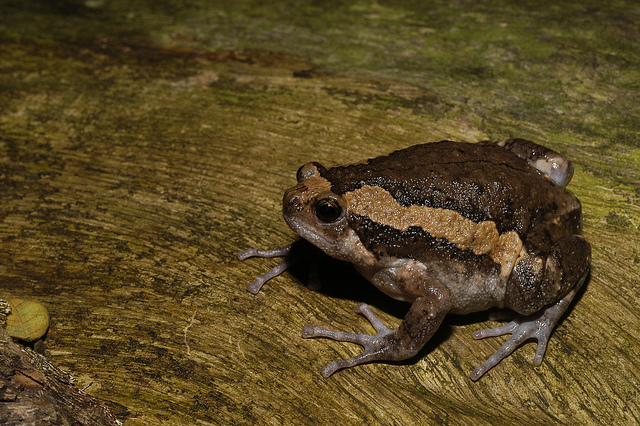
Photo: Alex Figueroa, NParks Flora & Fauna Web
|
Scientific name: |
Kaloula pulchra |
|
Common name: |
Banded Bull Frog |
|
Family: |
Microhylidae |
What does it look like?
This chubby frog has a relatively small head, making its body look very round. Its toes are elongated with blunt tips. It is easily identified by the thick, black-edged, pale orange bands that extend from its head and down to the sides of its body.
You can usually hear its loud, cow-like bellows before and after heavy rain in built-up urban areas.
Behaviour and Ecology
Diet and Behaviour
The Banded Bull Frog feeds mainly on small invertebrates such as ants and termites. When threatened, it will inflate itself while releasing poisonous mucus.
Where are they found?
It is a highly adaptable species that thrives in disturbed habitats like flooded grasslands, roadside puddles and urban drains. In the day, it hides in burrows under leaf litter or in the crevices of walls or buildings.
The Banded Bull Frog is found in southern China, southern India, Sri Lanka and Southeast Asia.
Did you know?
Despite being very slow, these frogs are voracious eaters. They can consume up to a few hundred ants in a single night!
East Asian Ornate Chorus Frog

Photo: Law Ing Sind
|
Scientific name: |
Microhyla fissipes |
|
Common name: |
East Asian Ornate Chorus Frog |
|
Family: |
Microhylidae |
What does it look like?
It is a tiny frog about the size of a small marshmallow, with equally small tadpoles. It has a small and pointed head, and long and slender hind legs. Its body is triangular in shape and is olive brown in colour, with a pale stripe running down both sides of its body.
Behaviour and Ecology
Diet and Behaviour
These frogs are nocturnal and feed mainly on insects. They lay their eggs in muddy puddles.
Where are they found?
This frog is found in central China, Japan and Taiwan and the Malay Peninsula. They are believed to have been introduced to Singapore, and specimens were first found on Pulau Tekong in 2005. They live in many types of habitats like lowland forests, grasslands and urban areas.
Dark-sided Chorus Frog
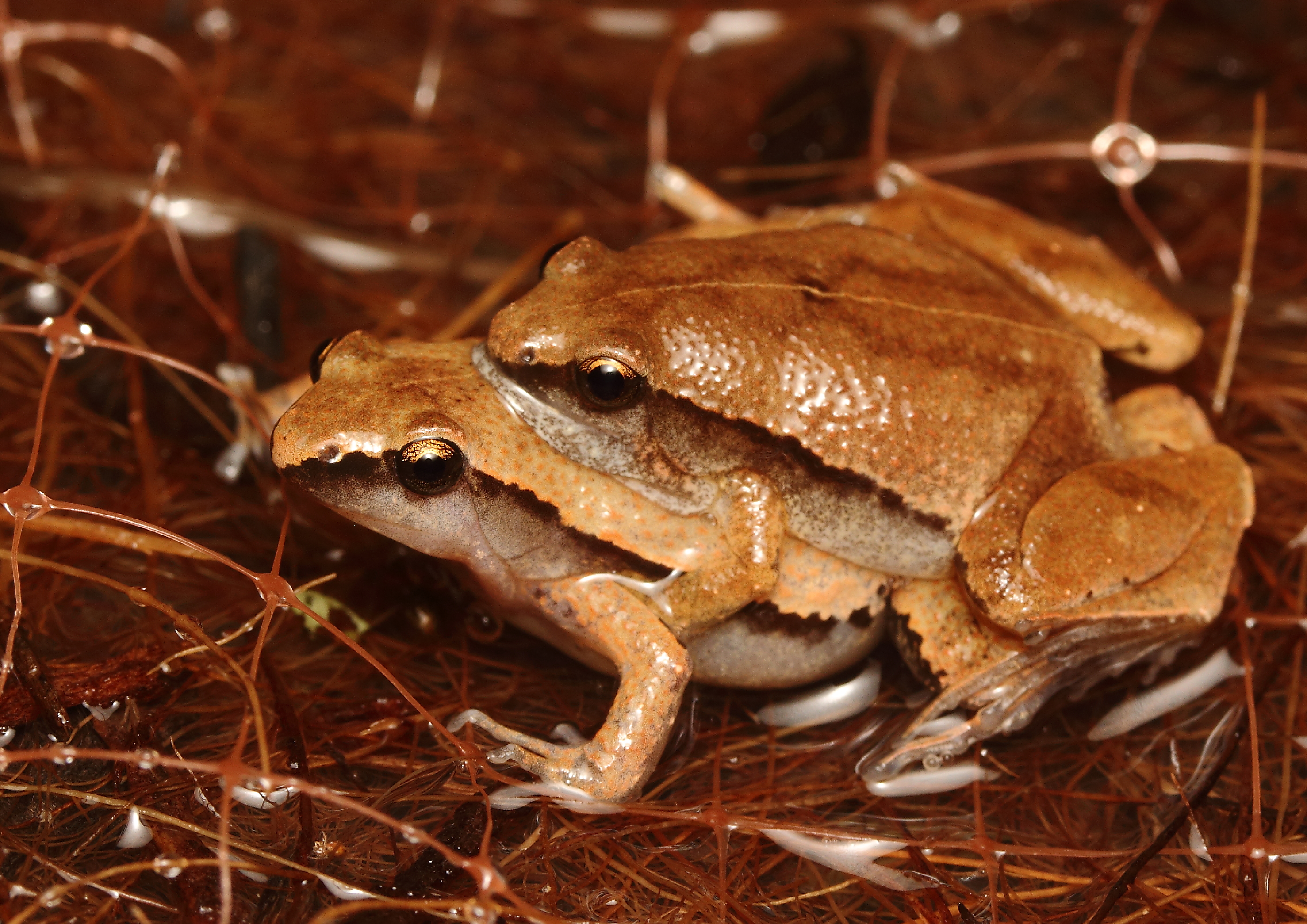
Photo: Law Ing Sind
|
Scientific name: |
Microhyla heymonsi |
|
Common name: |
Dark-sided Chorus Frog |
|
Family: |
Microhylidae |
What does it look like?
This tiny native frog is similar in both size and shape to the introduced East Asian Ornate Chorus Frog but is yellowish brown with a thin white stripe along its back and a white belly.
It has distinctive black bands running along its sides. Tadpoles have a white band over their heads.
Behaviour and Ecology
Diet and Behaviour
These frogs are nocturnal and feed on insects. Due to their tiny size, they are often overlooked but their loud calls in the evening, which are a series of rapidly repeating loud kriiiiik sounds, usually give away their presence.
Where are they found?
The distribution of this species ranges from southern China to the Malay Peninsula, Singapore and Sumatra. They are often found near small puddles and ponds in rural areas, parks and gardens. They are also found on offshore islands like Pulau Ubin and Pulau Tekong.
Field Frog
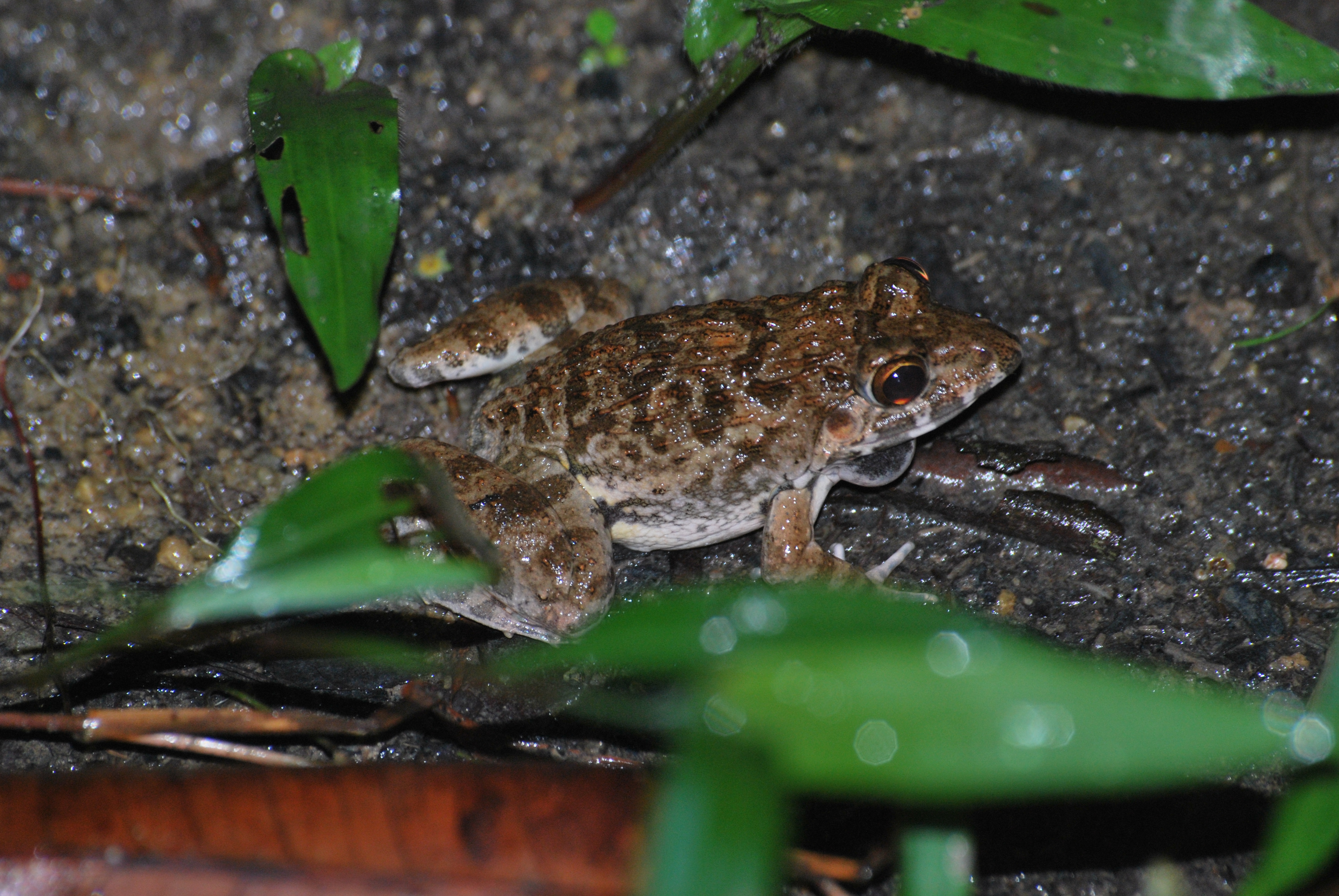
Photo: Daniel Ng (NParks)
|
Scientific name: |
Fejervarya limnocharis |
|
Common name: |
Field Frog |
|
Family: |
Dicroglossidae |
What does it look like?
It has muscular hind legs with half-webbed hind feet. Its back is grey or brown with irregular black blotches.
Behaviour and Ecology
Diet and Behaviour
These frogs are nocturnal and feed on insects. Its tadpoles live at the bottom of shallow puddles and ditches. Its calls are similar to the Asian Toad but start off slow and get faster towards the end. They lay large clutches of eggs in stagnant water.
Where are they found?
It is a common native frog that can be found in built-up urban areas, gardens, and nature reserves. Its distribution ranges from India and Sri Lanka, South China, East Asia down to Thailand, Peninsular Malaysia, Singapore and Indonesia.
Crab-eating Frog
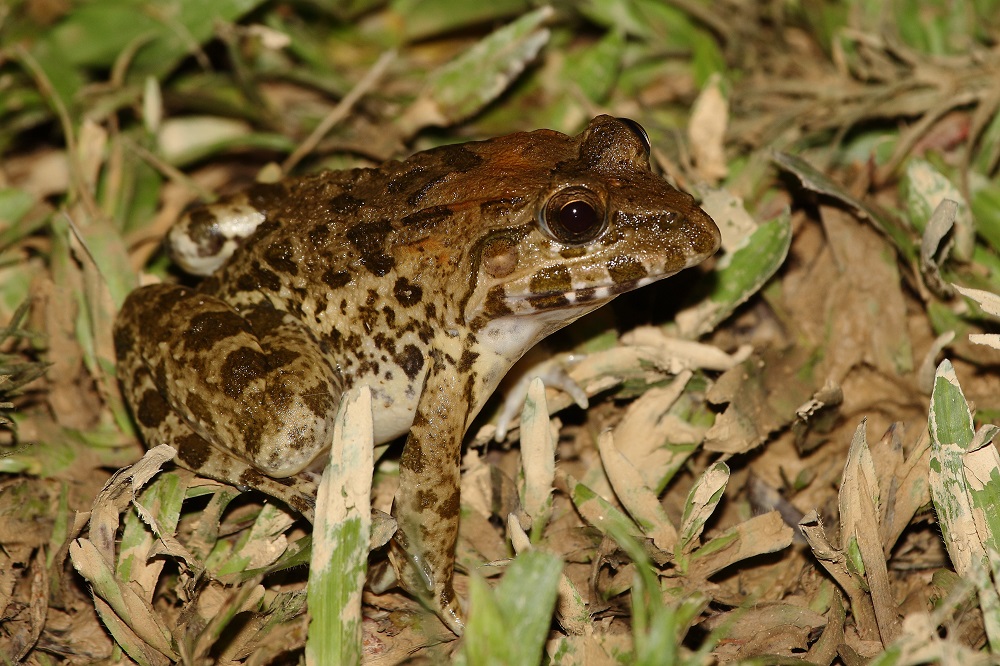
Photo: Law Ing Sind
|
Scientific name: |
Fejervarya cancrivora |
|
Common name: |
Crab-eating Frog |
|
Family: |
Dicroglossidae |
What does it look like?
These are large frogs with similarly large tadpoles. Despite being much larger than the Field Frog, smaller individuals can still be misidentified due to their similar markings. However, this species differs from the Field Frog as its hind limbs are extensively webbed.
Behaviour and Ecology
Diet and Behaviour
Despite their name, they mostly feed on insects at night. However, they are generalists and will also consume crustaceans like Tree-climbing Crabs in the mangroves. Their calls sound like gargling, making them stand out from other frogs in the area.
Where are they found?
In Singapore, they can be found in both freshwater and brackish water environments like mangroves. Outside of Singapore, they can be found in India, Indochina, Sri Lanka and across Southeast Asia.
Did you know?
The Crab-eating frog can tolerate salt water. It can adjust its body to adapt from freshwater to seawater within a few hours. It does this by increasing and retaining the urea concentration in its body, so it doesn’t lose water to its surroundings through osmosis!
Asian Toad
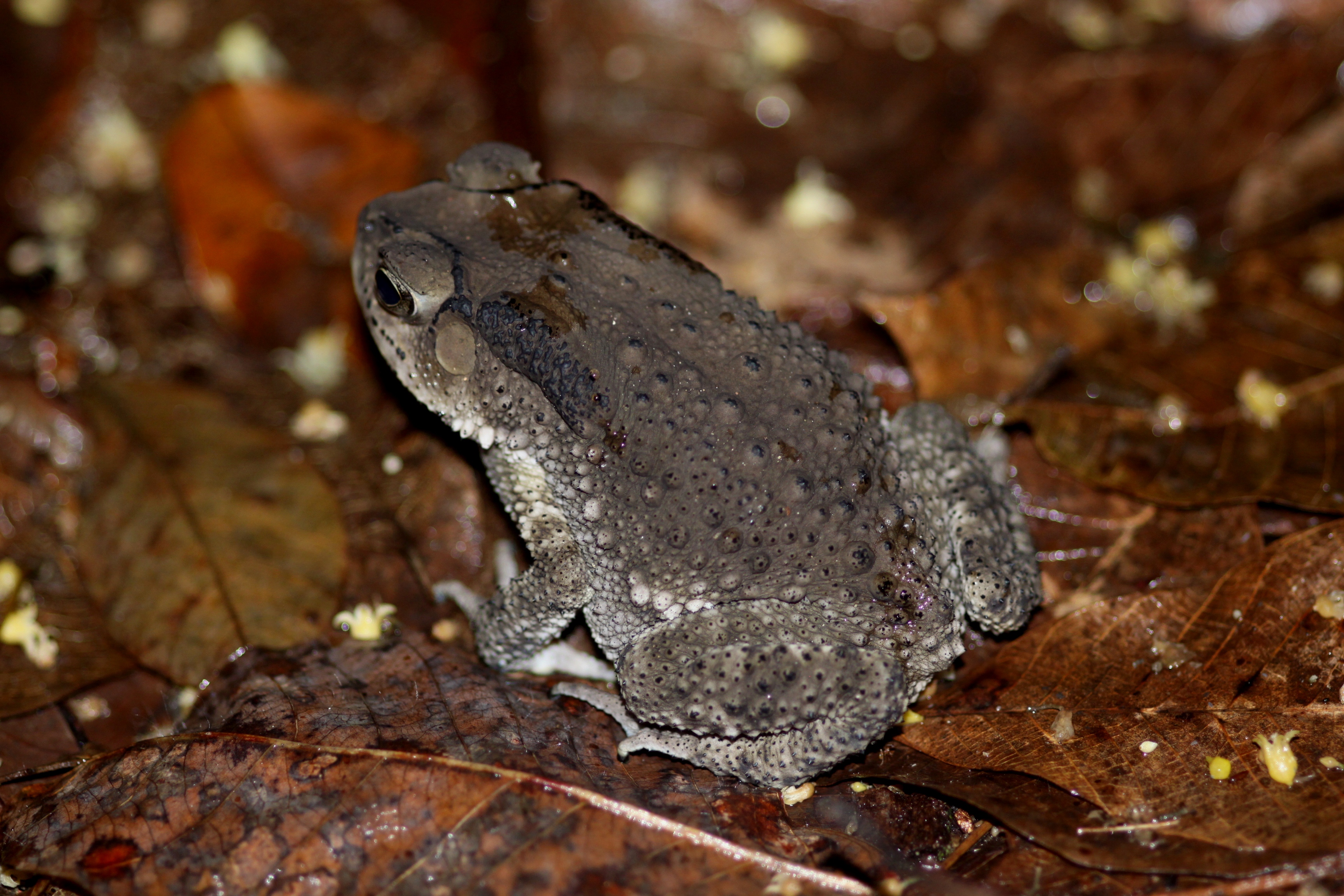
Photo: Holly Siow, NParks Flora & Fauna Web
|
Scientific name: |
Duttaphrynus melanostictus |
|
Common name: |
Asian Toad |
|
Family: |
Bufonidae |
What does it look like?
Being a true toad, it has a stout body and dry skin, unlike frogs which have moist skin. Several bony ridges run along the top of its head, while the raised glands behind its eyes (lightly coloured ovals) are very obvious. Two black stripes run down the top of its head as well. Their tadpoles are tiny and blackish, about the size of a 10-cent coin.
Behaviour and Ecology
Diet and Behaviour
The Asian Toad feeds mainly on a wide range of invertebrates at night. Adult toads are usually found under the cover of rocks, leaf litter and logs during the day. They are known to sit under street lamps at night where they catch insects attracted to light.
Where are they found?
This native species can be found almost everywhere in Singapore. It is also widely distributed across East Asia and Southeast Asia, and has been introduced to Australia, Madagascar and Papua New Guinea.
Did you know?
When it feels threatened, it will inflate its body. It is also able to secrete toxins from its body to deter predators.
Banner: Malayan Water Monitor. Photo: Ruth Tan (NParks)

